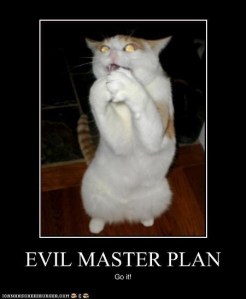►My Novel-Writing Methodology: Pre-Drafting
We all have a method to our novel-writing (even if we’ve never charted it out). These are the 7 steps I go through before I begin Draft One.
[Note: I have no illusions that this is my creation. I simply absorbed the ideas of multiple veteran writers and synthesized them into a working model for myself.]
1) Pure Musing
- After getting the seminal idea for the story, I spend time concentrating on it, but do no “physical work” whatsoever. No scribbling of anything, no charting and certainly no writing. I go on walks, stare out of windows, listen to the music which resonates with the story, and so on. I do nothing here but “feel it out.” I am daydreaming about the tale, but in an intentional way (IE, I set aside and devote time to it).
- Here in the pure musing stage I am feeling out the “huge thing” that is happening. I ask: “What is the predominant conflict in this tale, and how does the whole thing end? How does this story feel to me?”
2) Subconscious Programming and Questioning
[You can find a hundred experts in psychology and neuroscience discussing the subconscious, and at the end of the day, they really don’t know how it does what it does. I  certainly am no exception. But its efficacy is proven. If we guide our minds in a specific direction then we start seeing it work in the background, and powerfully so.]
certainly am no exception. But its efficacy is proven. If we guide our minds in a specific direction then we start seeing it work in the background, and powerfully so.]
- At this stage I begin asking myself multiple questions about the tale, and tell myself to “sort out X & Y.” Then, instead of concentrating on those things, I “let it go.” I instruct my brain to process multiple elements. Like most subconscious programming, this works most effectively as you’re preparing to go to bed. Within a couple of days, good answers are being “passed back up the chain” to my conscious mind.
3) Scribbling
- During this stage I write down the Macro stuff (all by hand). “What’s the overarching conflict and resolution?” I answer this on paper for the first time here. I’m still largely musing here, but I am starting to “form the clay.” For whatever reason, I do this best on large sheets of paper and whiteboards.
- I then start sketching out characters, plots, themes, subplots, etc.. I here write down questions for myself, like: “Why does he really want X?” and “What is the conflict between A & B when C happens?”
- The next stage of scribbling is to choose the characters in the tale. Names are important, so I spend the time finding appropriate ones. I then scribble out their function and how they contribute. I give myself general personalities to these people, asking “Why” to each aspect. I can usually at this point assign Enneagram types and levels to each person (since I know the Ennea well).
4) Structure and Architecture
 [As I’ve mentioned I have read a plethora of books on the craft of writing. Many contain important lessons, but the one which seems to stand out as crucial to me at this point in my writing life is the understanding of how all good stories are structured. There is, I believe, a universal archetype—a physics to how a good tale works. I understand that this is debatable, but that’s not the focus of this post. I’ll give a review of this paradigm in another post. But, anyway…]
[As I’ve mentioned I have read a plethora of books on the craft of writing. Many contain important lessons, but the one which seems to stand out as crucial to me at this point in my writing life is the understanding of how all good stories are structured. There is, I believe, a universal archetype—a physics to how a good tale works. I understand that this is debatable, but that’s not the focus of this post. I’ll give a review of this paradigm in another post. But, anyway…]
- I here chart out the tale according to the Story Engineering method of Larry Brooks. [There are multiple, similar structure paradigms out there (and most of their differences are just semantical), but I use this one.] Each complete story has (4) stages, and each stage has its own mission to fulfill. [See THIS.]
- So, I here begin to chart out the tale, seeing how it should unfold according to these stages. I spend considerable time here, for this serves as the backbone of the entire tale. If I get this wrong, multiple other things will go wrong down the road.
5) Guided Musing & Subconscious work
- I now look at what I have done in #3-4 and concentrate on those details. I am back to the “feeling it out” stage, but in a less amorphous fashion. Looking at the structure I ask myself, “OK, does this work? Does this compel the reader?” Again, answers begin presenting themselves in short order.
6) Scene Charting
a. Chart out the main events (9-10) that are at the fore of pushing the tale along. These are the “tent-poles” or “milestones” of the tale.
i. I simply write out:
1. Who is in the scene? Where is the scene? What’s the mission of the scene?
b. Having scrutinized (a), I now sketch out every single scene in the novel.
i. This is the short version. I do the same as (i)- 1) above, but for everything.
c. Now I spend time reading (b) over and over again. I then perform the same musing/subconscious work as in #5.
d. I type up a scene summary for each of those scenes.
i. Here I include:
1. POV, Setting, Mission, etc. Some of the summaries are 2 sentences, others take up an entire page. Sometimes I will write out key lines delivered by a character.
e. I print out (d) and read it over and over.
f. I sit down with these printouts. I ask myself questions. I make notes on it, and then correct it in the doc.
g. I do exactly as I did in (e).
7) Ponder and Prepare to Write
I am now holding in my hands the entire story—each scene of the book (in summary fashion). I’ll now ask myself a battery of questions about all of the major elements of the novel. I work to fix what’s flawed.
Only now do I begin Draft One. Of course, some things will emerge that need changed, but this method saves me a truckload of time and demoralizing frustration down the road by reducing the quantity/depth of revisions.
[See related post on Planning vs. Pantsing]
~Daniel

~~
~~
~~
~~
~~
~~
~~
~~
This entry was posted on December 11, 2013 by Daniel Ionson. It was filed under ►The Craft of Writing and was tagged with Arts, author, charting, craft of writing, draft, Enneagram, fantasy, fantasy books, fantasy novels, fantasy writing, Fiction writing, Larry Brooks, novel, story, Subconscious, Subconscious Programming, writer, Writer Resources, writers.
I learn so much from your blogs and they are so well written. Thank you.
December 11, 2013 at 8:25 pm
Thanks for sharing, Daniel! I can relate to the subconscious guidance and how it is the key ingredient no matter what method you use. And I’m going to get my hands on Larry’s book – looks like it has some useful fodder.
December 12, 2013 at 12:26 am
Excellent! But I think I could never be a novel-writer though. 😉 It is so tedious. As always Daniel, you amazed me.
December 12, 2013 at 9:26 am
Gosh, this makes me dowright lusty for writing.
December 12, 2013 at 7:42 pm
I love that you feel your novel before you write it. I am usually way too impatient to do this. Beyond that, I don’t think I could hold all of that information in my brain without it leaking key points! I am a very visual learner, so I have to see things on paper before I can pull together concepts, create links and develop scenarios (probably why I am such a bad chess player – I can only see one or two steps ahead in my brain – to do more i would need to plot it out on paper!)
December 15, 2013 at 1:26 am
Hi Mik… I certainly need to chart everything out as well. But I’ve learned the power of consistently/consciously returning to my “musing” side.
I like your blog… Will learn from it.
Daniel
December 15, 2013 at 1:32 am
Pingback: I’ve got an idea… | How Do I Write A Novel...???
Pingback: ►Started Tapping the Keyboard | Daniel Ionson
Pingback: ►The Actual Writing | Daniel Ionson
Pingback: Author in the Spotlight: Daniel Ionson | A Fantasy Writing Journey
Pingback: ►Story Structure or, “What I learned from the Three Little Pigs” | Daniel Ionson